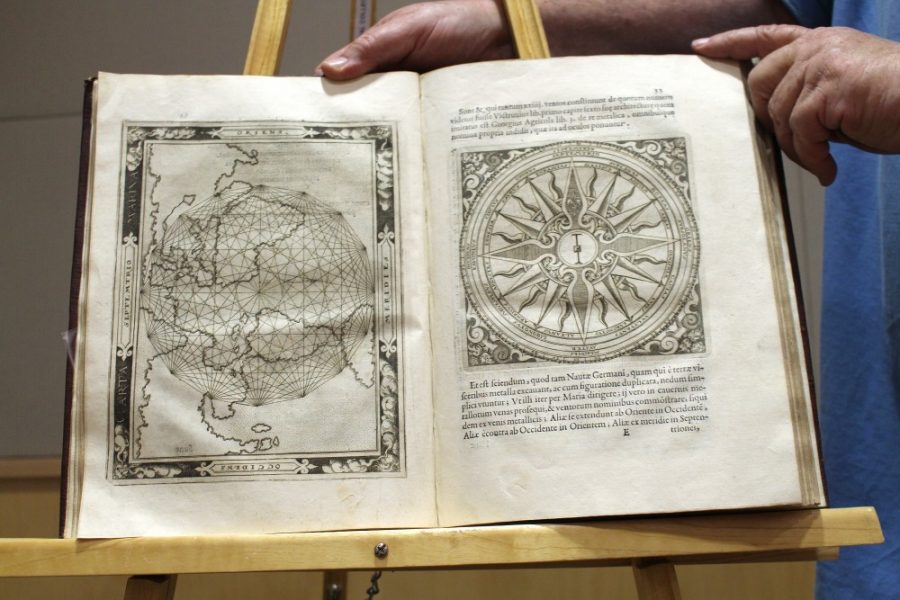Adjacent to the Main Library, in the building with the double glass doors, lays a significant and often overlooked collection of history. Special Collections is part of the UA Libraries and contains rare books, printed materials, photographs, literature and more. The collection is open to researchers, scholars and the public.
“We want everybody to feel that they can come in and use our resources,” said Stephen Hussman, the director of Special Collections at the University Libraries.
The primary research materials available at Special Collections are mainly in the fields of Arizona and Southwestern history, literature and science.
The collection includes rare books, such as a 1482 print of “Euclid’s Elements;” southwestern history, like old mining records, colonial manuscripts and the papers of Edward Abbey; and facsimiles, or exact copies of materials, including “La Biblia De San Luis.”
Hussman said the goal of the library, functioning within a land-grant university, is to make the collections accessible to the widest possible population.
“Everyone is welcome to use our collections, and we want to reflect the diversity and inclusivity of our community,” Hussman said.
Materials at Special Collections aren’t checked out like normal books in the library. Curious scholars and citizens can request materials in the library reading room and spend time observing and reading through items. Upon the first check-out, visitors will sign a permission form and read through a handling guide.
Depending on the rarity and fragility of materials, visitors may be required to wear rubber gloves or wash their hands again before handling. Photography and copying services are available.

Hussman said the legacy and history of Arizona is preserved in Special Collections and the collections hold materials dating back to when the university was first founded.
RELATED: UA museum highlights pharmacy history
Hussman said serving the campus community in the success of its students and faculty as part of the land-grant mission is a “wonderful job.”
“I love this work,” Hussman said. “It’s a lot of fun, and I get to meet some great people being part of a great group of colleagues here in the library and really reflecting the mission of our library.”
The library holds exhibits regularly. The current exhibit is titled “Visions of the Borderlands, Myths and Realities.”
When Veronica Reyes-Escudero, Borderlands curator and associate librarian at Special Collections, joined in 2004, the library began collecting more U.S.-Mexico borderlands materials.
She co-curated the exhibition with her colleague, associate librarian Joseph “Bob” Diaz.
Reyes-Escudero said the exhibition is for viewing depictions of myths and realities of the first part of the 20th century through images.
Materials on exhibit include film posters, photography, printed materials and books highlighting historical borderland themes. Icons from the period included in the exhibit are Geronimo and Pancho Villa.
Hussman said that the exhibit “really highlights the history of the borderland region and also really tries to dispel the myths of what a lot of people felt this area was. It wasn’t just dude ranches and open desert. There’s a lot of culture here; there’s a lot of history here.”
The exhibit started on Jan. 23 and is open to the public in the Special Collections lobby during library hours through June 30.
“Special Collections is open to students, faculty and to the public, so we invite you to come in and view,” Reyes-Escudero said. “The exhibition offers a glimpse of what is here, so you might be interested in looking through that to see if there’s something you might want to research further.”

Special Collections started in 1958 as an Arizona collection and gradually grew to encompass materials from the borderlands and beyond.
Roger Myers, rare book librarian at Special Collections, said that the collections are all about keeping a record of the history, science and growth of people living in this area over time.
RELATED: When you work in a museum, you got to dance
“They have both contemporary and historic records that help people who live in Tucson, in Arizona or in the Southwest figure out what went on before, and what’s going on now,” Myers said.
Much of the materials in the collections are donated, while others are purchased or gifted after someone’s passing.
Myers helps acquire materials for the university, working with the different colleges and researchers based on the UA community’s needs.
“Our goal here is to buy materials for the faculty and students to come use in their research,” Myers said.
The Special Collections library is open from 9 a.m. to 6 p.m. Monday through Friday. The next exhibit hosted by Special Collections, “After 500 Years: Print and Propaganda in the Reformation,” opens Aug. 7 and will run through Dec. 22.
More information, including a collection guide and lists of materials, can be found online.
Follow on Isaac Andrews on Twitter









